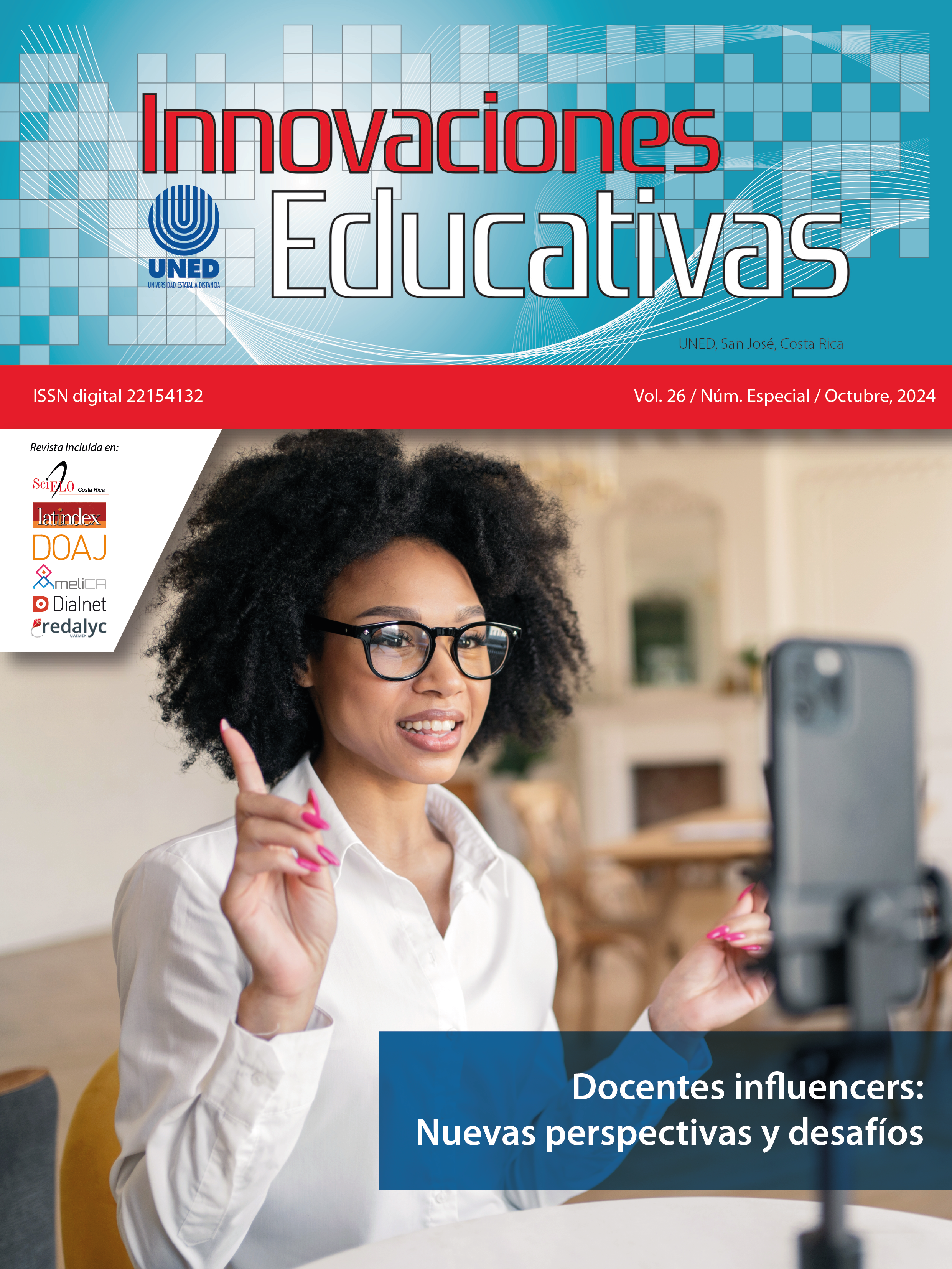Conceptualizing the "self" in social networks. Affection and narrative between the verbal and the nonverbal
DOI:
https://doi.org/10.22458/ie.v26iEspecial.5391Keywords:
Conceptualization, social networks, affect, story, ; healthAbstract
This essay reflects on the subject's contemplation of the "self" when exporting one's personal image to social networks with the intention of being accepted.
It interpellates the reader through a critical reflection and proposes the approach of a hypothetical prosumer (Toffler, 1980) who brings a version of the "self" with which they identify or try to fit between reality and desire. This is an interdisciplinary and multitextual approach to the way the subject communicates through positive parameters a face, a body and a life (Erikson, 1974; Festinger, 1957; Kaplún, 1998).
We observe the recurrence of showing oneself, either with a real and genuine image or manipulated to the point of creating an idealized version (Barker, 2020; Koffermann, 2024).
It is proposed to redesign some workshops that aim to promote self-confidence, strengthen acceptance strategies and open up to diversity. Furthermore, an essay format is chosen to analyze the impact of the different versions of the self-image of adolescents in social networks on teacher training in media education (https://www.redalfamed.org/vii-congreso-2024-costa-rica). Constructive discussion will be used to offer guidelines for intervention in both the educational and health fields.
The strategies are based on the analysis of the multimodal story that emerges from the definitions with which each subject projects his or her "self".
References
Acuña Rodríguez, M.C. (2024). Transdisciplinariedad y ecoformación: principios ético-filosóficos para la educación superior, Revista Innovaciones Educativas Vol. 26, N. 40, 203-222. https://doi.org/10.22458/ie.v26i40.4800
Barker, J. (2020). Making-up on mobile: The pretty filters and ugly implications of Snapchat, Fashion Style and Popular Culture, 7 (2-3), 207-221. DOI: 10.1386/fspc_00015_1
Domingo Osle, R. y Rodríguez-Fraile Díaz, G. (2022). Espiritualizarse. Amazon Italia Logística S.r.l.
Erikson, E. (1974). Identidad, Juventud y Crisis. Editorial Paidós.
Festinger, L. (1957). A Theory of Cognitive Dissonnance. Stanford University Press.
González Andrés, G. y Liñares Gutiérrez, A.M. (2023). Los cuentos que nos motivaron a ser lo que somos. SalTerrae.
Kaplún, M. (1998). Una pedagogía de la comunicación. Editorial de la Torre.
Koffermann, M. (17 de mayo de 2024). Redes Sociais e a construção da autoimagem dos adolescentes, Boletim Salesiano. Red Salesiana Brasil (Brasil). https://www.boletimsalesiano.org.br/
Palacios, J., Coll, C. y Marchesi, Á. (1990). Desarrollo psicológico y procesos educativos (cap. 25), en Jesús Palacios, Álvaro Marchesi y César Coll (compiladores), Desarrollo psicológico y educación, I (367-383). Alianza Psicología.
Picado Sánchez, M.J. y Sibón-Macarro, T.G. (2024). ¿Cómo definimos al otro? El contexto de inmigración en el aula, Interpretación, razón y cultura: perspectivas hermenéuticas. 214- 238. Dykinson.
Picado Sánchez, J.M. y Sibón-Macarro, T.G. (2023). A propósito de la definición: una propuesta de revisión innovadora, IV Congreso Internacional de Formación Permanente Nodos del Conocimiento. Doi:10.13140/RG.2.2.20513.17764.
Ramírez García, A.; Gutiérrez Arenas, Mª P. y Poyato López, Fco. J. (2021). Familias ON. Grupo Comunicar. Colectivo Andaluz de Educación en Medios de Comunicación (https://www.grupocomunicar.com/pdf/familias-on.pdf).
Samaniego, J.M. (2021). Alfabetización mediática y digital: De particularidades a encuentros y posibilidades, 16th Iberian Conference on Information Systems and Technologies (CISTI). https://doi.org/10.23919/CISTI52073.2021.9476428.
Sánchez Carrero, J.; Contreras Pulido, P. (2012). De cara al Prosumidor: Producción y Consumo Empoderando a la ciudadanía 3.0. Revista ICONO 14. Revista científica De Comunicación y Tecnologías Emergentes 10 (3). 62-84. https://doi.org/10.7195/ri14.v10i3.210.
Sánchez Soberano, R.L. (2017). Fundamentos filosóficos de la pedagogía de la alteridad. Boletín Redipe, Vol. 6, Nº. 1, 58-67.
Sibón-Macarro, T.-G. y Romero Alfaro, E. (2024). El desarrollo de las habilidades comunicativas en Educación Primaria y el ODS-4, en Juan Casanova Correa y Montserrat Vargas Vergara (coords.) La inclusión de los ODS en educación superior. (pp. 141-156). Octaedro.
Sibón-Macarro, T.-G. (2024). Formación docente y educomunicación. Diseño y preparación de píldoras educativas sobre lectura y salud, Innovación, investigación y transferencias ante la era de las Inteligencias Artificiales. (pp. 730-753). Dykinson.
Sibón-Macarro, T.-G. y Picado Sánchez, M.J. (2021). Animación a la lectura a través de reseñas booktubers, Sección III: Nuevas alfabetizaciones y redes sociales: Procesos de enseñanza-aprendizaje en la era digital; Arantxa Vizcaíno Verdú, Mónica Bonilla del Río, Noelia Ibarra Rius (coords.) Cultura participativa, fandom y narrativas emergentes en redes sociales (pp. 612-635). Dykinson.
Sibón-Macarro, T.-G. (1994). Consciencia e inconsciencia en el yo como proceso, en Juan Bargalló Carraté (coord..) Identidad y alteridad, aproximación al tema del "doble", (pp.191-204). Alfar.
Toffler, A. (1980). La tercera ola. Plaza y Janes.
Downloads
Published
How to Cite
Issue
Section
License
Copyright (c) 2024 Innovaciones Educativas

This work is licensed under a Creative Commons Attribution-NonCommercial-NoDerivatives 4.0 International License.

